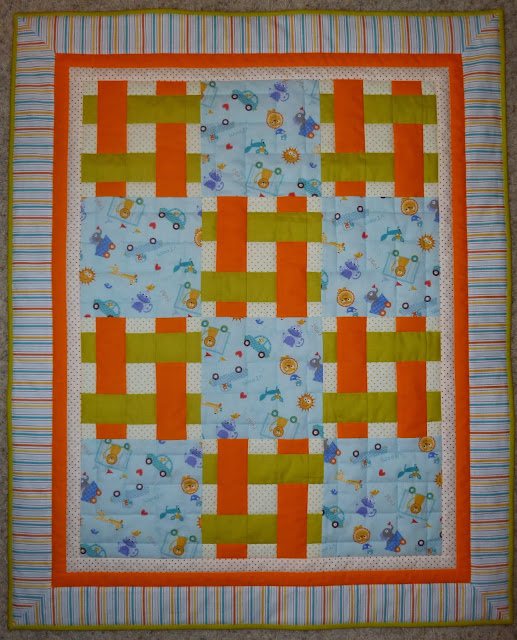POW!
The name of this quilt refers to the "explosive" nature of the optical illusion, and also as a suggestion to the viewer to get the maximum effect.
Here is the illusion: ALL of the squares are actually square, and ALL of the lines are actually straight! Yes!!! Go ahead....take a ruler or whatever and match it up to any line on the photo. I'll wait...........SEE!!!!!!!!!!
This illusion is known as "The Bulging Checkerboard". Here is a
link which shows how the mind overrides what the eye is actually seeing. Watch what happens as the slider moves and the small squares disappear. And here is another
link showing this effect created using Legos!
One thing that I find very interesting is that the effect is way more evident in the photos than in the actual quilt (although, as I said, if you stand back a ways and squint it is readily visible).
Can anyone out there explain why this is so? Could it be that because the camera's image is smaller the effect is more pronounced?
This FREE pattern was created by
Krista Zaleski. Her version is a huge 102" square. The blocks are 6" x 6" finished. Since this really needs to be hung on a wall to get the full effect, I scaled mine down to one-quarter of hers. So it is 51" x 51" (3" blocks). Even so, it still contains 1,275 pieces! The smallest ones are 1 3/8" x 5/8"! TINY!!!! Each of the "diagonal" blocks is actually a modified 9-patch! The horizontal and vertical axis squares are made of 7 pieces each.
I quilted it on a diagonal (black thread in the black squares; cream in the cream) to emphasize the bulge.
There is a hanging sleeve on the top of the back. I also put corner triangles on the back bottom so it can use a wooden dowel (or other similar oblect) to add a little weight and keep the quilt taut. All the better to promote the illusion.
And here's the good news: I am giving this quilt away for free* to one of my faithful readers! Just email me your name by noon Central this Friday. I will put all the names in a 55-gallon drum and pull out one lucky winner.
*No legalese; just a disclaimer: If you are not in the Chicago area and you are the winner, you will have to pay either: a) postage for me to send it to you, or b) airfare if you want me to hand deliver it. Your choice.
Update: The drawing for the quilt was won by Mibby Novak, a fellow quilter and travel friend from Pennsylvania. Congratulations Mibby!!!!!


















